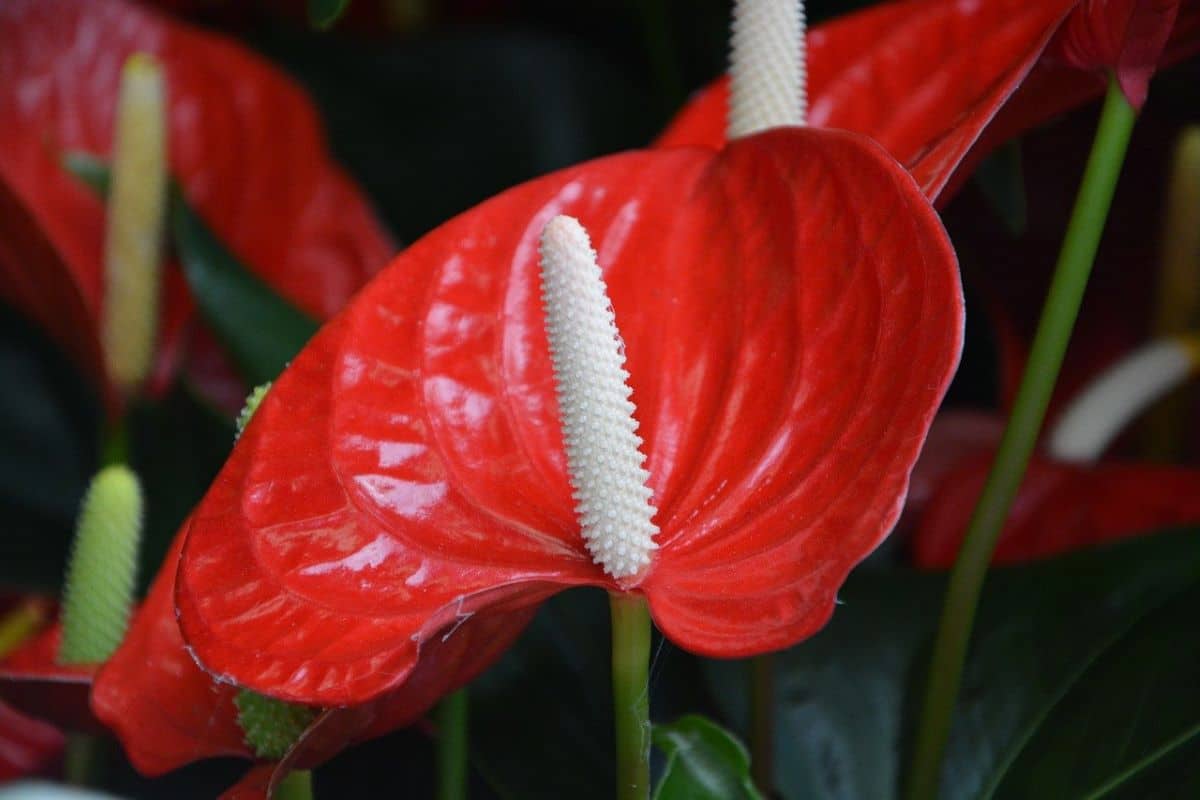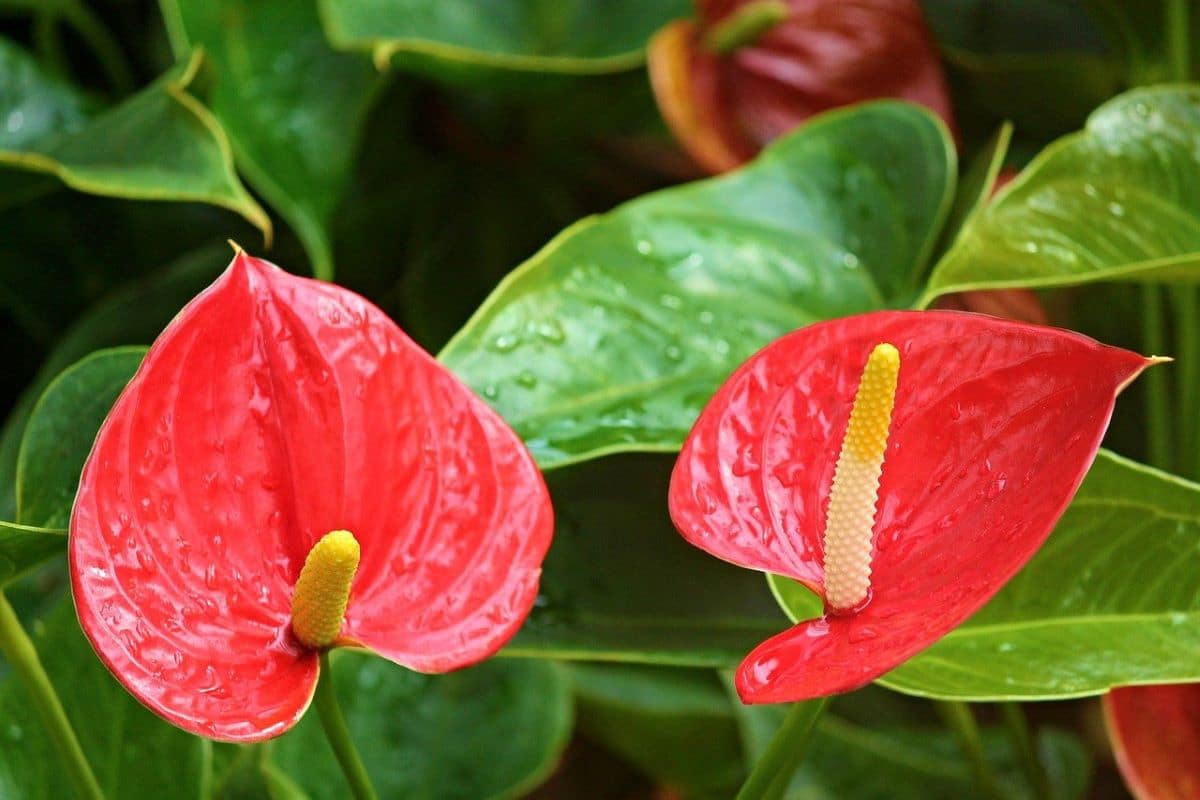
El anthurium andreanum It is one of the most cultivated anthurium species, if not the most, especially indoors. As it is very sensitive to cold, there is often no choice but to protect it at home, something that is very popular, as it gives the room a unique exoticism.
It is a relatively small plant, which you can grow in a medium-size pot without problems. Well more or less. The truth is that this type of anthurium, like the rest, is a bit demanding with everything: water, land, location. So, we are going to tell you what care you have to provide.
Origin and characteristics of Anthurium andraeanum

Image - Flickr / Maja Dumat
This is a herbaceous plant that belongs to the family of the araceae, and that grows naturally in Colombia and Ecuador, where we will find it in the tropical jungles. In common or popular language it is known as a flamenco flower, flamingo, or anthurium. Reaches about 40 centimeters in height, developing rounded leaves of a showy bright green color.
The flower is an inflorescence composed of a cartilaginous spathe, red or pink in color, which is about 10 centimeters long. From it emerges a spadix about 9 centimeters long, white and / or yellow, formed by numerous very small hermaphrodite flowers. The fruits are fleshy berries.
You have to know that it is a toxic plant for mammals. All its parts contain calcium oxalate and saponins that cause severe irritation, excessive salivation and vomiting if ingested. For this reason, if there are small children, dogs, cats and / or any other mammalian animal at home or in the garden, the plant should be kept away from them. In addition, if you are going to prune, you must use rubber gloves -such as kitchen ones- because if its sap comes into contact with the skin you could feel intense itching, and even blisters would appear.
What are the care of the flamingo flower?
El anthurium andreanum It is a plant that has to be given specific care in order for it to grow properly. If we fail at something, we will immediately see that its leaves turn yellow, or that it weakens and that pests attack it.
To make it last for many years, we are going to explain in depth what you need to know to take care of your anthurium:
Location
- Body exterior:: it is a plant that needs shade, and also a high humidity. In addition, it cannot stand the cold, so it is recommended to have it outside the home only during the spring and summer months. If the humidity is low, its leaves can be sprayed with distilled or rain water, once a day, except in the hottest weeks, which will be twice / day.
- Interior: when we have it inside the house, we will put it in a room where there is a lot of light. Likewise, it is important that it is not exposed to air currents (fans, air conditioning, passageways, etc.), otherwise the leaves will dry out. And if the humidity is low, we will put containers with water around it.
Soil or substrate

Image - Wikimedia / Michael Gäbler
- Garden: The Anthurium andraeanum grows in soils rich in nutrients and acids. As is typical of tropical forests, it must be planted in lands that have organic matter, that is, that are rich. Likewise, it is necessary that when watering the water be absorbed quickly, so if it is not so we will mix the earth with perlite (for sale here) or pumice (for sale here).
- Flower pot: in the event that it is wanted, or must be kept in a pot, we will look for one that is the right size for it to grow. What will that be? Well, if the old pot measures 10,5 centimeters in diameter, the next one must be about 17 cm. And remember: with holes in its base. We do not want the water to remain stagnant in the roots, and that these rot, right?
As a substrate, one will be used for acidic plants (for sale here), or coconut fiber (for sale here).
Irrigation
Irrigation of the flamingo has to be moderate. It will be watered with rainwater or poor in lime, so that the substrate, or the soil if it is planted in the ground, always remains moist but not flooded. If doubts arise, the ideal is to insert a wooden or plastic stick: if when removing it we see that a lot of soil has adhered to it, then we will not water because it will mean that it has not dried yet.
If it is potted, it is preferable not to put any plate or tray under it. The water would accumulate there, and if we do not remember to drain the dish, the roots will die in water.
Subscriber
So that it can grow and flourish well, it is advisable to pay at Anthurium andraeanum in spring and summer with fertilizers such as guano (for sale here), or fertilizers for indoor plants (on sale here), acid plants (for sale here) or flowering plants.
Of course, you do not have to mix them, since if you do, the roots would suffer significant damage. What you can do is use one month one, and the next a different one, but always following the instructions specified on the package.
Pruning
Pruning consists of removing dried leaves and flowers. This is done at any time of the year, using scissors previously disinfected with pharmacological alcohol or dish soap.
Plagues and diseases
- Mealybugs: especially the cottony. It is found in the leaves and tender stems. They can be removed by cleaning the plant with mild soap and water. Afterwards, all traces of soap have to be removed, just with water.
- Aphids: they are insects of about 0,5 centimeters that we will find in the leaves and flowers. They can also be removed simply by cleaning the plant, but if they reappear it will be better to use ecological anti-aphid insecticides such as this.
- Root rot: there are various fungi that rot the roots, such as the phytophthora. These thrive in very humid environments, so that if the plant receives more water than it needs, it becomes vulnerable to infection. The symptoms are: yellow leaves that quickly turn black, the plant stops growing, and the flowers do not finish opening (if any). It is treated with multipurpose fungicides (for sale No products found.), but it is also important to space the risks.
Rusticity
It is a plant very sensitive to cold. When the temperature drops below 15ºC it must be protected inside the house, or inside a greenhouse. To be really comfortable, you need temperatures to be maintained between 20 and 30ºC throughout the year and that the ambient humidity is at least 70%.

What did you think of the anthurium andreanum?